I recently enjoyed a first-rate plate of pasta in a little Italian restaurant in Botolph Alley (of which more later). It’s just around the corner from Monument, but a more scenic way to get there, if you were so inclined, would be to set off from Tower Hill – and zig zag your way there via a few nifty off-the-main-drag detours, thus avoiding a lot of the city traffic and enjoying a few landmarks, gardens and cobbled lanes along the way.
Tower Hill to Trinity Square Gardens
From Tower Hill tube enter Trinity Square Gardens.
This wide lawned oasis is perfect escape from the bustle around the Tower. It is essentially a garden of memorials, to those who were executed in centuries past as martyrs or enemies of the state, and those who died in the Falklands War of 1982, but the largest is the Mercantile Marine Memorial dedicated to the memory of those who in wartime, ensured the flow of essential goods and supplies, navigating treacherous waters in unarmed vessels.
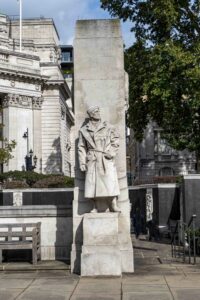
The WW1 memorial – an open tunnel vault shaped structure was designed by Edwin Lutyens, (who also designed the Cenotaph in Whitehall). In dignified classical style it stands strong and assertive, while its counterpoint – the WW2 memorial directly opposite designed by Edward Maufe, takes the form of a sunken garden with chapel-like extensions either side, its entrance marked by 2 pylons with figures of an officer and merchant seaman at either end. In the garden there are allegorical reliefs representing the seven seas designed by sculptor Charles Wheeler who also created the reliefs adorning the façade of the Bank of England.

Four Seasons Hotel, Trinity Square
The most arresting sight in the area though is the imposing Four Seasons Hotel at 10 Trinity Square. Formerly the headquarters of the Port of London Authority.
By the late 1800s the Port of London was congested and inefficient. Ships could wait for up to a fortnight to unload and pilfering was rife, with the chaos made worse by myriad competing independent dock companies and striking dockworkers, which was all hugely frustrating for the ship owners.
The PLA was established in 1909 to take overall control of a 69 mile stretch of the river from Teddington to the Estuary, to put an end to the fierce competition between dock companies, regulate river traffic, remove wrecks, as well as oversee dredging of the river bed to facilitate the new larger iron-hulled ships.
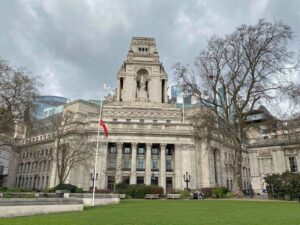
The headquarters at 10 Trinity Square designed by Edwin Cooper, was designed to show off London’s self – proclaimed status as the world’s greatest Port. Characteristic of Beaux Arts style it boasts a grand classical entrance with 6 columns three storeys high, while giant sculptures – allegories of Exportation, Produce, Commerce and Navigation – show off the building’s function. Atop the tower stands the unmissable Michelangelo-style figure of Father Thames pointing forever seawards.
The PLA moved out of 10 Trinity Place in the 1970s – and today the imposing building – which the architectural historian Nikolaus Pevsner described as ‘showy, happily vulgar and extremely impressive’ – has morphed into a luxury hotel.
Seething Lane to All Hallows by the Tower
To the left of the Four Seasons continue along Muscovy street and you will emerge into Seething Lane. Here you might take a few minutes to relax in the leafy shade of Seething Lane Garden, or continue right to the junction with Hart Street and visit the little Church of St Olave, well known both for its association with the diarist Samuel Pepys (he and his wife are buried here) and for the skulls and crossbones over the entrance gate, which prompted Charles Dickens to refer to it as ‘St Ghastly Grim’ – which it truly is not. In fact, it’s entirely charming and colourful and unusually ‘homely’ for a city church. There’s a lunchtime service on Tuesdays at 12.30, and this year the Annual Pepys Commemoration Service takes place on 23rd May at 12.00. All are welcome.
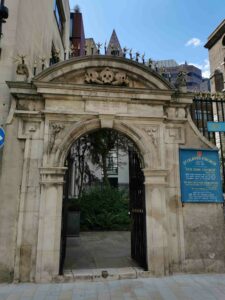
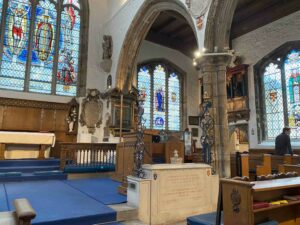
Turn back along Seething Lane and you’ll see All Hallows by the Tower across the main road straight ahead. There’s so much of interest here including the museum in the crypt, and the rare example of an Anglo-Saxon Arch made from reused roman stonework and tiles.
St Dunstan’s Hill to Lovat Lane
From All Hallows, cross over the busy junction at Byward Street (if the Hung Drawn and Quartered pub is in front of you, you’re on the right track). Continue along Great Tower Street and turn left into St Dunstan’s Hill.
Turn right into the idyllic St Dunstan in the East and take a few minutes to revive in this picture perfect city garden complete with Wren church ruins, water feature and cheeky squirrels. It’s currently greening up beautifully, ready to be photographed and enjoyed to the full.
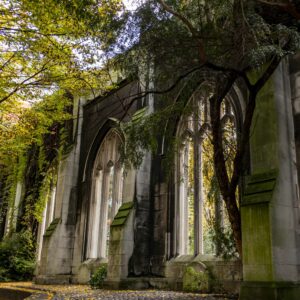
Exit on the far side into Idol Lane and follow the lane down as it winds into St Dunstan’s Lane, emerging into St Mary At Hill. Turn right and walk up past the rear of St Mary at Hill church with its big blue clock on the wall and enter though the iron gate on the left marked Entrance to Church. This will lead you through the quiet little church garden and into the church vestibule, where the church’s Resurrection Panel is on display. Dating from the 1670s it depicts the last Judgement and was likely created as a message of hope after a turbulent decade: the Civil war, the Plague and the Great Fire which devastated so many lives.
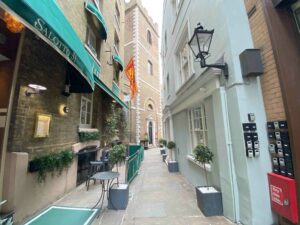
Emerge into Lovat Lane, a scenic slice of medieval London that runs from Eastcheap down to Billingsgate, so charmingly picturesque you’ll want to take one more photo before stepping straight across from the church into Botolph Alley where you’ll find the highly recommended L’Antipasto City (probably best to book in advance or turn up early – it gets very busy at lunchtimes).
Bon Appetit!
L’Antipasto City, 2-3 Botolph Alley | Off Botolph Lane, London EC3R 8DR Tel: 020 7283 7000
